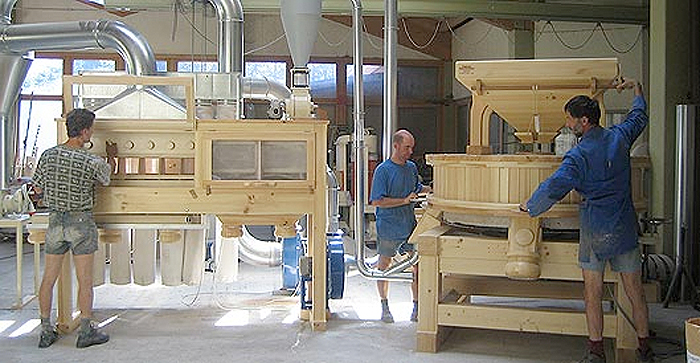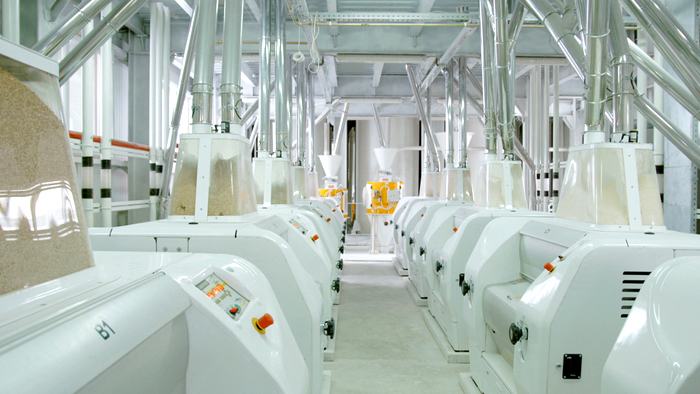Share This
Which method produces better flour: grinding with traditional millstones or with modern steel roller mills? Before we share our thoughts, take this simple true-or-false quiz to see what you already know about milling grains into whole grain flour – flour that contains all of the grain kernel’s original bran, germ and endosperm. We’ll reveal the answers throughout the blog.
|
T or F |
1. Stoneground flour is always healthier and more natural than flour made in big industrial steel-roller mills. |
|
T or F |
2. If the label says “stoneground wheat” the flour is always whole grain. |
|
T or F |
3. Before steel-roller mills became widespread in the late 1800s, all flour was whole grain. |
|
T or F |
4. Modern steel-roller mills don’t really produce whole grain; they leave out part of the germ or bran or both – and FDA says that’s okay. |
Is stoneground flour healthier? Some popular websites and books say that traditional stone mill wheels grind grain more gently, at a lower temperature than the big industrial mills called roller mills. Temperature’s important, because high temperatures can destroy key nutrients in grains.
Research shows, though, that stone mills generally operate at much higher temperatures than roller mills – as high as 90°C/194°F for stones vs. 35°C/95°F for roller mills. Plus, roller mills work so efficiently that the flour they produce is held at top temperatures only briefly, while stone mills take longer to reduce the grain to flour particles. That could explain why some data show stone-milled flour having greater loss of amino acids and healthy fats.
Stoneground grains often have a larger particle size than those ground in roller mills. This means that breads made from them may have a slightly lower glycemic index (healthier for your blood sugar). At the same time, though, studies show that vitamins and minerals may be less bio-available in larger particles. We give #1 a False, based on the data. Whole grain flour has the potential to be healthy either way, as long as the miller has taken care with the process.
Does stoneground always mean whole grain? Roller mills usually divide flour into separate “streams” as they grind it, then recombine everything to produce whole grain flour. Stone mills keep everything all together during grinding, in what’s known as single-stream milling. But that doesn’t mean millers couldn’t sift out some or all of the bran after the flour is milled, so while #2 is usually true, stoneground is no guarantee of whole grain, so read labels carefully. And that leads us to some interesting history….
Was all flour whole grain before roller mills? Before I started working with the Oldways Whole Grains Council, I had a more “black and white” view of grain history. I figured pretty much everyone ate healthy whole grain bread before roller mills became widespread, and then zap, suddenly white bread was everywhere, right? Wrong.
Historic sources show that two thousand years ago Roman millers sifted their flour to create a whiter bread for their better-off clients, and the practice persisted through the centuries. (After all, no one knew about the health benefits of bran and germ, but they knew white flour kept fresh longer and was easier to bake with.) That quaint gristmill by the stream in colonial America, in fact, often included sifters and shakers to remove some of the bran (along with rocks and dirt). That said, older sifting processes weren’t very thorough, so the flour likely kept more of its good stuff than today’s white flour. Conclusion: #3 turns out to be False as well.
Is industrial whole wheat flour really whole? Another widespread rumor has it that industrial roller mills leave out part of the original wheat kernel – often the germ, whose unstable healthy fats shorten the flour’s shelf life. One way to check this is on the flour’s Nutrition Facts Label. White (refined/enriched) flour has total fats of under 1%, while whole wheat flour has about 2.5% total fats. If the germ had been taken out, the fats would be similar to white flour.
In the U.S., federal regulations require that all of the wheat’s original bran, germ, and endosperm “remain unaltered” for flour to be called “whole wheat flour.” While we can’t vouch personally for every miller in the country, we call “False” on the claim that industrial whole wheat flour isn’t really whole grain.
If you’re reading this in Canada, however, be aware the Canadian law allows up to 5% of the original wheat kernel to be missing in “whole wheat flour” – so all of the germ and a bit of bran is often left out. If you’re Canadian, look for “whole grain whole wheat” – a term that would be redundant in the U.S.
It’s all good. Our conclusion is that all sources of whole grain flour contribute to making delicious breads, crackers, pasta and other foods, and you can’t go wrong with either fresh stone-ground flour or fresh, good-quality roller-milled flour. (You can even mill your own at home!) In fact, what happens to that flour after it leaves the mill may affect its health benefits more than anything that happens during milling. We’ll be looking into some of those factors in the coming weeks. (Cynthia)
Sources: Information in this blog, unless otherwise linked, comes from the article “Nutritional Impacts of Different Whole Grain Milling Techniques: A Review of Milling Practices and Existing Data.” Cereal Foods World, May/June 2015, Volume 60, Number 3, by Julie Miller Jones, Judi Adams, Cynthia Harriman, Chris Miller, and Jan-Willem van der Kamp.
This is the first post in our series on whole grains and processing. Click below to read the related posts in this series:



Comments
Add a Comment